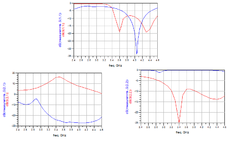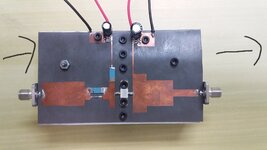Mabrok
Full Member level 4

Dear All,
please I need your help and advise upon the following:
I have designed and fabricated PA, during the simulation the results was very good. During the measurements using VNA "Keysight E5071C model", I got unexpected S22 (almost 0 dB), and also S21 (below 0 dB). For S11 I think it is acceptable which just shifted by 500 MHz to the high frequency.
Additional information which may help:
Target frequency band: 3.4-3.6 GHz
I have used an external attenuator of 30 dB
During measurements, I just performed 2 port calibration and connected the device to the ports of VNA and applied bias.
I have attached the photo of the fabricated device and simulation (red) versus measurements (blue) results.
Thanks in advanced
please I need your help and advise upon the following:
I have designed and fabricated PA, during the simulation the results was very good. During the measurements using VNA "Keysight E5071C model", I got unexpected S22 (almost 0 dB), and also S21 (below 0 dB). For S11 I think it is acceptable which just shifted by 500 MHz to the high frequency.
Additional information which may help:
Target frequency band: 3.4-3.6 GHz
I have used an external attenuator of 30 dB
During measurements, I just performed 2 port calibration and connected the device to the ports of VNA and applied bias.
I have attached the photo of the fabricated device and simulation (red) versus measurements (blue) results.
Thanks in advanced






